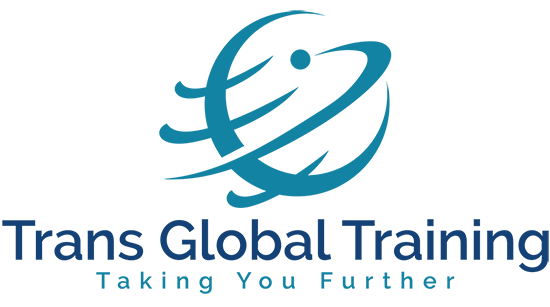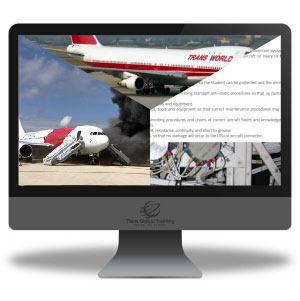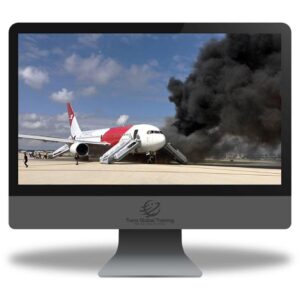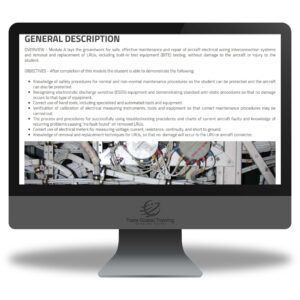
Shop
HF, EWIS TG 1&2, FTS Phase 1&2 Continuation
£85.00
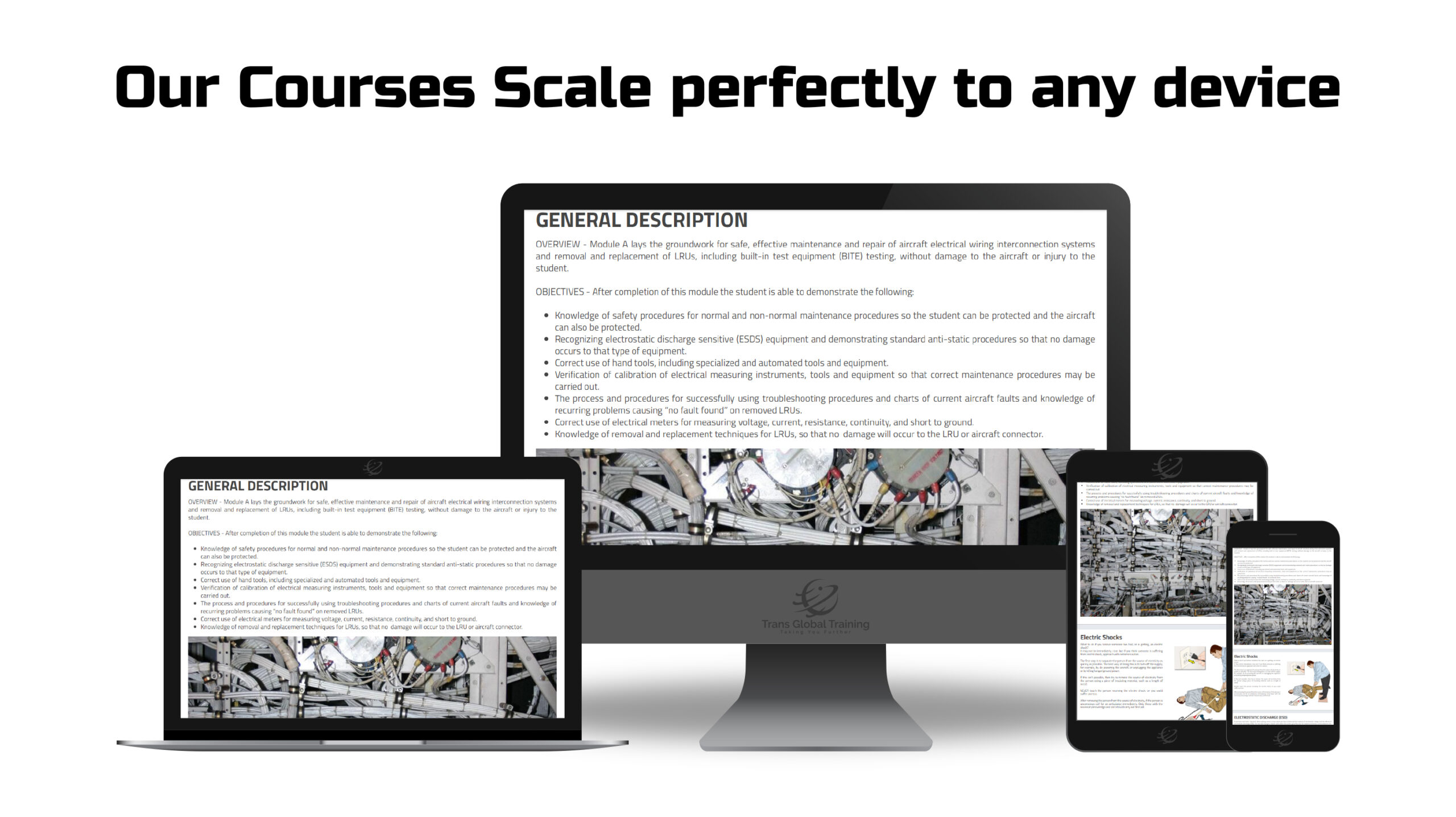
ABOUT
Human Factors Refresher/Continuation course complies with EASA AMC 2 145.A.30(e) and is suitable for;
- Post-Holders, managers, supervisors
- Certifying staff, technicians and mechanics
- Technical support personnel such as, planners, engineers, technical record staff, Quality
- Control / Assurance staff
- Specialised service staff
- Human Factors Staff / Human Factors Trainers
- Store department staff, purchasing department staff
- Ground Equipment operators
- Contract staff in the above categories
This course contains a minimum of 10 hours study time
EWIS continuation training course complies with EASA AMC 20-21 &AMC 20-22 and FAR 25, Subpart H—Electrical Wiring Interconnection Systems (EWIS)
This course contains a minimum of 10 hours study time
ABOUT
This EWIS continuation course is for;
TARGET GROUP 1 – Personnel Performing Electrical Wiring Interconnection Systems Maintenance. These personnel work directly at maintaining or modifying EWIS. Examples of these personnel are:
- FAA – A & P technicians.
- EASA – Part 66 Cat B1 and Cat B2 personnel.
TARGET GROUP 2 – Personnel Performing Maintenance Inspections on EWIS. These personnel perform EWIS inspections but do not directly maintain or modify EWIS. Examples of these personnel are:
- FAA – A & P technicians.
- EASA – Part 66 Cat B1 and Cat B2 personnel.
Fuel Tank Safety Continuation Training Phase 2 course
This course will require approximately 10 hours of study time IAW EASA rule Annex 1 to Decision 2009006/R Appendix XII to AMC to M.A.706(f) and M.B.102(c)
TGT training follows EASA Document EASA ED 2009/007/R issued in March 2009 and FAA AC 120-97A regulations.
The course is concerned with large aeroplanes as defined in Decision 2003/11/RM of the Executive Director of the Agency (CS25) and certified after 1 January 1958 with a maximum type certified passenger capacity of 30 or more or a maximum certified payload capacity of 7500 lbs (3402 kg) cargo or more, and Large aeroplanes as defined in Decision 2003/11/RM of the Executive Director of the Agency (CS25) which contains CS25 amendment 1 or later in their certification basis.
The training is for;
- Quality managers and quality personnel.
- Personnel of the competent authorities responsible for the oversight as per M.B.704 of aeroplanes type certified passenger capacity of 30 or more or a maximum certified payload capacity of 7500 lbs (3402 kg) cargo.
- Personnel of the M.A. Subpart G organisation involved in the management and review of the continuing airworthiness of aircraft specified above
- Any personnel involved in the maintenance of aeroplanes type certified with a passenger capacity of 30 or more or a maximum certified payload capacity of 7500 lbs (3402 kg) cargo.
For all the full course syllabuses, please click on DESCRIPTION below
Description
SYLLABUSES
This aviation Continuation Human Factors course complies with AMC/GM TO ANNEX II (PART-145) TO REGULATION (EU) No 1321/2014 GM 1 145.A.30(e) Personnel requirements TRAINING SYLLABUS FOR INITIAL HUMAN FACTORS TRAINING
SYLLABUS FOR HUMAN FACTORS CONTINUATION TRAINING
- General/Introduction to safety management and human factors
1.1. Need to address safety management and human factors
1.2. Statistics
1.3. Incidents
- Safety risk management
la.l. Hazard identification
la.2. Safety risk assessment
la.3. Risk mitigation and management
la.4. Effectiveness of safety risk management
- Safety Culture/Organisational factors
2.1 Justness/trust
2.2 Commitment to safety
2.3 Adaptability
2.4 Awareness
2.5 Behaviour
2.6 Information
- Human Error
3.1. Error models and theories
3.2. Types of errors in maintenance tasks
3.3. Violations
3.4. Implications of errors
3.5. Avoiding and managing errors
3.6. Human reliability
- Human performance & limitations
4.1. Vision
4.2. Hearing
4.3. Information-processing
4.4. Attention and perception
4.5. Situational awareness
4.6. Memory
4.7. Claustrophobia and physical access
4.8. Motivation
4.9. Fitness/health
4.10. Stress
4.11. Workload management
4.12. Fatigue
4.13. Alcohol, medication, drugs
4.14. Physical work
4.15. Repetitive tasks/complacency
- Environment
5.1. Peer pressure
5.2. Stressors
5.3. Time pressure and deadlines
5.4. Workload
5.S. Shift work
5.6. Noise and fumes
5.7. Illumination
5.8. Climate and temperature
5.9. Motion and vibration
5.10. Complex systems
5.11. Other hazards in the workplace
5.12. Lack of manpower
5.13. Distractions and interruptions
- Procedures, information, tools and practices
6.1. Visual inspection
6.2. Work logging and recording
6.3. Procedure – practice/mismatch/norms
6.4. Technical documentation – access and quality
6.5. Critical maintenance tasks and error-capturing methods (independent inspection,
reinspection, etc.)
- Communication
7.1. Shift/task handover
7.2. Dissemination of information
7.3. Cultural differences
- Teamwork
8.1. Responsibility
8.2. Management, supervision and leadership
8.3. Decision-making
- Professionalism and integrity
9.1. Keeping up to date; currency
9.2. Avoiding error-provoking behaviour
9.3. Assertiveness
- Organisation’s safety programme
10.1. Safety policy and objectives, just culture principles
10.2. Reporting errors and hazards, internal safety reporting scheme
10.3. Investigation process
10.4. Action to address problems
10.5. Feedback and safety promotion
SYLLABUS FOR EWIS TG 1&2 CONTINUATION TRAINING
Module A – GENERAL ELECTRICAL WIRING INTERCONNECTION SYSTEM PRACTICES
Know or demonstrate safe handling of aeroplane electrical systems, line replaceable units (LRU), tooling, troubleshooting procedures, and electrical measurement.
1. Safety practices
2. Electrostatic discharge sensitive (ESDS) device handling and protection
3. Tools, special tools, and equipment
4. Verifying calibration/certification of instruments, tools, and equipment
5. Required wiring checks using the troubleshooting procedures and charts
6. Measurement and troubleshooting using meters
7. LRU replacement general practices
Module B – WIRING PRACTICES DOCUMENTATION
Know or demonstrate the construction and navigation of the applicable aeroplane wiring system overhaul or practices manual.
8. Standard wiring practices manual structure/overview
9. Chapter cross-reference index
10. Important data and tables
11. Wiring diagram manuals
12. Other documentation as applicable
Module C – INSPECTION
Know the different types of inspections, human factors in inspections, zonal areas and typical damages.
13. General visual inspection (GVI), detailed inspection (DET), special detailed inspection (SDI), and zonal inspection, and their criteria and standards
14. Human factors in inspection
15. Zonal areas of inspection
16. Wiring system damage
D – HOUSEKEEPING
Know the contamination sources, materials, cleaning and protection procedures.
17. Aeroplane external contamination sources
18. Aeroplane internal contamination sources
19. Other contamination sources
20. Contamination protection planning
21. Protection during aeroplane maintenance and repair
22. Cleaning processes
E – WIRE
Know or demonstrate the correct identification of different wire types, their inspection criteria and damage tolerance, repair and preventative maintenance procedures.
23. Wire identification, type and construction
24. Insulation qualities and damage limits
25. Inspection criteria and standards for wire and wire bundles
26. Wire bundle installation practices
27. Typical damage and areas found (aeroplane specific)
28. Maintenance and repair procedures
29. Sleeving
30. Unused wires – termination and storage
31. Electrical bonding and grounds
Module F – CONNECTIVE DEVICES
Know or demonstrate the procedures to identify, inspect, and find the correct repair for typical types of connective devices found on the applicable aeroplane.
32. General connector types and identification
33. Cautions and protections
34. Visual inspection procedures
35. Typical damage found
36. Repair procedures
G – CONNECTIVE DEVICE REPAIR
Demonstrate the procedures for replacement of all parts of typical types of connectors found on the applicable aeroplane.
37. Circular connectors
38. Rectangular connectors
39. Terminal blocks – modular
40. Terminal blocks – non-modular
41. Grounding modules
42. Pressure seals
FUEL TANK SAFETY CONTINUATION TRAINING SYLLABUS
Phase 2
The course includes
- a short background showing examples of FTS accidents and incidents
- the description of concept of fuel tank safety and CDCCL
- examples of manufacturers documents showing CDCCL items
- typical examples of FTS defects,
- examples of TC holders repair data
- examples of maintenance instructions for inspection
The student will, after the completion of the training:
- Have knowledge of the history of events related to fuel tank safety issues and the theoretical and practical elements of the subject
- Have an overview of the FAA regulations known as SFAR (Special FAR) 88 of the FAA and EASA
- Be able to give a detailed description of the concept of fuel tank system ALI (including Critical Design Configuration Control Limitations CDCCL
- Have the capacity to combine and apply the separate elements of knowledge in a logical and comprehensive manner
- Have knowledge on how the above items affect the aircraft
- Be able to identify the components or parts or the aircraft subject to FTS from the manufacturer’s documentation
- Be able to plan the action or apply a Service Bulletin and an Airworthiness Directive
- Have an understanding of the background and the concept of fuel tank safety
- Understand how technicians can recognise, interpret and handle the improvements in the instructions for continuing airworthiness that have been made or are being made regarding fuel tank systems
- Have an awareness of any hazards especially when working on the fuel system, and when the Flammability Reduction System using nitrogen is installed.
- Understand the theoretical background behind the risk of fuel tank safety: the explosions of mixtures of fuel and air, the behaviour of those mixtures in an aviation environment, the effects of temperature and pressure, energy needed for ignition etc, the ‘fire triangle’
The student will be introduced to;
- 2 concepts to prevent explosions:
- ignition source prevention
- flammability reduction
- Understand the major accidents related to fuel tank systems, the accident investigations and their conclusions
- Understand SFAR 88 of the FAA and JAA Interim Policy INT POL 25/12: ignition prevention program initiatives and goals, to identify unsafe conditions and to correct them, to systematically improve fuel tank maintenance),
- Understand the concepts that are being used: the results of SFAR 88 of the FAA and JAA INT/POL 25/12: modifications, airworthiness limitations items and CDCCL
- Understand how relevant information can be found and how to use and interpret this information in the various instructions for continuing airworthiness (aircraft maintenance manuals, component maintenance manuals…),
- Fuel Tank Safety during maintenance: fuel tank entry and exit procedures, clean working environment, what is meant by configuration control, wire separation, bonding of components etc,
- Flammability reduction systems when installed: reason for their presence, their effects, the hazards of a Flammability Reduction System (FRS) using nitrogen for maintenance, safety precautions in maintenance/working with an FRS
- Recording maintenance actions, recording measures and results of inspections.
